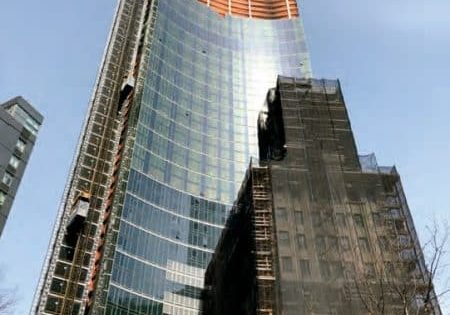Rethinking “Rescue”
Jun 1, 2020
In this Readers’ Platform, your author makes the case for abolishing the term.
by Michael J. Ryan
I have long been troubled by the general public’s attitude about a stalled elevator. A stall happens infrequently, yet there’s a rush to escape the car. Just look at recent media headlines about those being assisted in a stalled elevator:
- “New York Woman Rescued After Spending Three Days Trapped in Elevator”
- “FDNY Cuts Through Wall in Elevator Rescue”
- “Boston Firefighters Make New Year’s Eve Elevator Rescue”
- “Pope Francis Gets Stuck in a Vatican Elevator, Rescued by Firefighters”
- “Firefighters Rescue Man Stuck Inside Elevator in Fort Lauderdale”
- “18 Rescued After Being Trapped in [Kansas City] Elevator”
Here’s a recent web post: “Being trapped in a confined elevator is everyone’s worst nightmare. You’re hanging stories above the ground, and your only lifeline is the emergency call button in front of you.” To which I replied, “Really? Is this everyone’s worst nightmare? It wouldn’t be on my short list.”
Let’s take a deeper dive into the definition of the word “rescue” and what it implies. To “rescue” is a verb, an action word. In the past tense: “rescued,” to save someone from a dangerous or distressing situation. As an example, “Firemen were called out to rescue a man trapped in the river.”
While I worked full time for The Peelle Co., I spent my early adulthood as a volunteer paramedic in my hometown of Long Island, New York. I responded to thousands of rescues involving victims requiring emergency medical treatment and transport, as well as management of their families and bystanders. A stalled elevator doesn’t often rise to the level of a dangerous or distressing situation. Furthermore, what other means of stalled transportation requires rider rescue? AAA doesn’t rescue stranded drivers, and subway riders aren’t rescued when there’s a power outage. These events are never reported in the media.
Why is press coverage of elevators sensationalized? The news media definitely sensationalizes elevator and escalator accidents, both during and after installation. While such accidents may involve a fatality, a stalled elevator is a controlled situation that is being mischaracterized. When an elevator is stalled between floors, riders may experience a range of emotions: frustration, nervousness, panic, inconvenience, etc. Why all the emotions, and what drives the urgency to be rescued? Certainly, the elevator community didn’t model or promote this behavior.
I Blame Hollywood
I blame Hollywood. They created an unrealistic experience when an elevator ride isn’t unremarkable. Think about Hollywood movies and how elevators are portrayed: Speed, The Shining, Die Hard, Devil, The Game, Elevator and more. These movies present troubling images with terrible consequences.
As a first responder, I believe that firefighters actually assist riders in a stalled elevator. They don’t rescue them. Additionally, elevator contractors should stop using the term “entrapment,” as it perpetuates the issue of a larger problem. Elevator call-center operators and office personnel should be retrained. Simply put, a situation in which an elevator is between floors and not responding to a call should be referred to as a “stall.” When elevator professionals speak at community, business or chamber of commerce meetings, they should also use the word “stall,” rather than “entrapment.”
The reality is that an elevator enclosure is a safe space, illuminated, in some cases climate controlled, with a phone or communications button, sometimes with TV/music/entertainment and often with Wi-Fi connectivity. The elevator community should encourage users and stakeholders to appreciate the value and service our equipment provides and, ideally, teach them to remain calm if something temporarily goes wrong.
A stalled elevator is a controlled situation that is being mischaracterized.
What Experts Say
What do elevator experts say? Tom Branham, HKA Consulting, observes:
“We’ve spent billions of dollars over the years on phones in elevators. We even put phone-line monitoring on the phone circuit. We consider a phone a life-safety device. The safest place if stuck is in the elevator. Firemen would not let us interfere with a fire in an elevator shaft; we should not let them interfere with us properly fixing an elevator. No disrespect to firemen, but we now have two-way communication with the elevator company. Once reported, I would propose a 2-hr window for firemen to circumvent any sense of urgency to remove people, unless there is a medical emergency.”
Doug Witham, retired, Adams, Courion and GAL/Vantage, states:
“I think more commonly. However, the word ‘rescue’ is understood to mean ‘to save from violence, danger or evil.’ It implies an emergency. In this sense, no one is ever rescued from a stalled elevator. The elevator industry knows there is no violence, danger or evil associated with this. There may be only a subtle difference, but I believe our industry — people who understand what is really involved when there is a stalled elevator — should discontinue using the term ‘rescue’ and replace it with the word ‘release.’ ‘Entrapment’ is another word that knowledgeable elevator types ought to find a replacement for. In the dictionary, the synonyms for entrapment are ‘trick,’ ‘trap,’ ‘frame,’ ‘set up’ and ‘sting.’ Really? The meanings of these words are almost diametrically opposed to events experienced by passengers in a stalled elevator.”
So, what are the chances you’ll get stuck in an elevator during your lifetime? According to an article by KJA Consultants Inc., an elevator engineering consultancy with offices throughout Canada:
“On average, for a well-maintained elevator installation, we would expect about 0.03 entrapments per month, per unit. So, if your exposure is 80 min. in 12,000 min. of elevator operation, you have a probability of entrapment each month of 0.02%, or one in 5,000. To put this in context, the odds that you will be struck by lightning in any given month are 1 in 3,360,000.”
I’m in my late 50s and have worked in the elevator business since age 19. I’ve surveyed hundreds of elevators during my career, and only once was I in an elevator that temporarily stalled.
An average office elevator makes about 400,000 trips per year. Elevators and escalators in an office building run about 10 hr per day. In offices with five working days per week, elevators operate approximately 260 working days, or 2,600 hr per year. If you use an elevator eight times each day in your office building and work 200 days per year, you will take 1,600 trips per year. If an installed lift experiences an average of 0.4 man traps per year, the probability of an entrapment during any single trip is 0.4/400,000, or 0.01% annually. If you travel 1,600 times up and down to your office in a year, your chance of getting trapped in
an elevator is 0.16%. During a 40-year working career, this means a roughly 6% probability of getting into a man trap in an office elevator. If you happen to live in a high-rise apartment building and use its elevators, your chance of getting trapped may rise to about 12% during 40 years of lift usage.
What do the numbers tell us? A small percentage of the population has been or will be in a stalled elevator in their lifetime. What can the elevator community do to communicate that a stalled elevator is a controlled and temporary situation? First, during your ongoing marketing campaigns, educate the local media and first responders that an elevator enclosure is a safe space and, that once the elevator is lowered to a floor for passenger egress, the stall is resolved. Second, where appropriate, educate the community, business or chamber of commerce organizations about this. Third, first responders and elevator technicians need to be reminded that they assist passengers in a stall; they do not rescue passengers from an entrapment. Forth, modify your internal business vernacular and retrain those who communicate with the public that passengers are stalled in the elevator, not entrapped. Fifth, reinforce the National Elevator Industry, Inc. (NEII) recommendations, “What To Do If You Are In A Stalled Elevator”:
The reality is that an elevator enclosure is a safe space, illuminated, in some cases climate controlled, with a phone or communications button, sometimes with TV/music/entertainment and often with Wi-Fi connectivity.
- “Push the ‘door open’ button. If you are near the landing, the door will open. You can slowly and carefully step out of the elevator. Be sure to watch your step as the elevator floor may, or may not, be level with the landing.
- “Remain calm if the door fails to open. You are still safe. Do not try to exit the elevator. Wait for trained emergency personnel to arrive. Even if the air temperature feels warm, there is plenty of air circulating in the elevator and its hoistway.
- “Press the alarm or phone button, and use any available communication systems. Push the alarm button and wait for someone to respond. In newer elevators, there will be a phone button, rather than an alarm button. When pushed, this will place a call to a party trained to take action (an elevator or alarm company, for example). The exact location of the building and elevator in which you are riding will be provided to the company. Some elevators have a two-way speaker system or telephone that allows for communication between you and building or rescue personnel. Do not be alarmed if you cannot be heard or if the phone does not work. Some phones are designed to only receive calls. Trained personnel should call when they arrive at the building.
- “Relax, and DO NOT try to extract yourself from the elevator. NEVER try to exit a stalled elevator car. It is extremely dangerous. ALWAYS wait for trained emergency personnel. Your best course of action is to relax, get comfortable and wait for professional assistance. You may be inconvenienced, but you are SAFE.”
“The word ‘rescue’ is understood to mean ‘to save from violence, danger or evil.’ It implies an emergency.” — Doug Witham, retired, Adams, Courion and GAL/Vantage
As members of the elevator community, no one wants to be associated with a product or service from which its users need to be rescued. Rather, we want to provide a safe and reliable mode of transportation. We need to reach out to elevator stakeholders to educate them about the valuable products and services we provide, as well how to handle an elevator stall. No rescue needed.
References
[1] urbo.com/content/trapped-what-to-do-when-an-elevator-gets-stuck/
[2] imperialelevators.com/how-often-do-elevators-break-down/
[3] wired.com/story/elevator-phone-phreaking-defcon/
Get more of Elevator World. Sign up for our free e-newsletter.






